Little Barford School
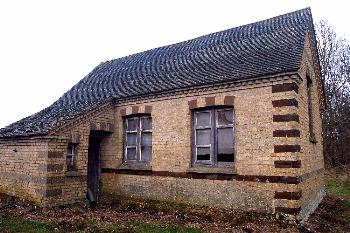
The former Council School February 2010
In 1870 Little Barford had no school. A preliminary statement was completed in 1878 for return to the central government Education Department with details of the new school [SDLittleBarford4/1]. This indicated that the school was a private one and the building belonged to Julius Alington, the Lord of the Manor. It was occupied rent free for educational purposes and was "one room unattached". The school was run in accordance with the principles of the Church of England and was also used as the Sunday School between 10 and 11 a. m. and 2.15 and 3 p. m. The building held 27 children and measured 27 feet by 15 feet. It had four windows and separate toilets and had been built in 1872, the date the school was established, the first teacher being Augusta Barnes, who was still there in 1904. The building survives, in a forlorn state at the time of writing [2010], on a piece of waste ground near the four pairs of houses numbered 1 to 8 Great Barford.
On 31st December 1879 a list of scholar was sent to the Education Department and the names and ages were as follows [SDLittleBarford4/1]:
- Flora Baker, 9;
- Samuel Baker, 4;
- Elizabeth Baringer, 6;
- John Bartholomew, 8;
- Zillah Bartholomow, 9;
- Ada Basson, 5;
- Ada Bennett, 10;
- Clara Bennett, 5;
- Ellen Bennett, 9;
- Harry Bennett, 7;
- Ada C. Brace, 10;
- Ada E. Brace, 7;
- Arthur Brace, 5;
- Emily Brace, 10;
- James Brace, 6;
- Louisa Brace, 8;
- Ada Bundy, 7;
- Flora Bundy, 9;
- George Bundy, 5;
- Emma Colins, 5;
- Fred Colins, 8;
- Arthur Gale, 8;
- Leonard Gale, 3;
- Clara Malins, 4;
- Flora Malins, 6;
- Elizabeth Nickolson, 8;
- Elizabeth Nickolson, 5;
- William Nickolson, 6;
- Elizabeth Sawyer, 10;
- Henry Sawyer, 7;
- Samuel Sawyer, 4;
- Arthur Smith, 5;
- George Smith, 4;
- Fred Stanton, 6;
- Martha Stanton, 11;
- Jenny Woods, 12;
- Mary J. Woods, 9;
- Susan Woods, 5.
In January 1880 the school inspector reported: "The School is orderly and the Teaching shews fair results considering the circumstances of the School. All the work, however, would require to be more perfected before the School could be regarded as a thoroughly satisfactory one".
![Plan of the school in 1904 [SDLittleBarford3/1]](/CommunityHistories/LittleBarford/LittleBarfordImages/Plan of the school in 1904 [SDLittleBarford3-1].jpg)
Plan of the school in 1904 [SDLittleBarford3/1]
A tenancy agreement of 1903 exists [SDLittleBarford3/2] in which Julius Alington leased the schoolroom to Rev. Nathaniel Royds, Rector of Little Barford, Charles Edmund Argentine Alington of Little Barford and Joseph Warrington of Little Barford, farmer, for seven years at a peppercorn rent provided the building was used as a school. A report of 1905 [SDLittleBarford4/1] states: "I am directed to inform you that after a visit paid to this School on the 11th April, H. M. Inspector reports that the school is not efficient as regards organization, discipline and instruction. The Board [of Education] are therefore unable to place the school on the list of Certified Efficient Schools".
The first school logbook [SDLittleBarford1/1] begins in September 1914 when the school had become a Council School due to the inefficiency of the old public elementary school. The first entry reads: "I, Elizabeth Barrett, have opened this school today. It is under the control of Bedfordshire Education Committee, and a local committee of managers consisting of Mrs. Alington, Mr. Alington - Chairman, the Rev. L. St. Aidan Baylee, Correspondent, Mr. A. Topham, Mr. J. Brace, Mr. H. Daniels. The Rev. L. St. Aidan Baylee, Mr. Topham and Mr. Brace were present at the opening. There were 26 children in attendance. The school has formerly been a private one, and 23 of the present scholars attended it".
Bedfordshire & Luton Archives & Records Service has a scrapbook of cuttings of visits made to most Bedfordshire Schools by School Inspectors for a period from just before the First World War through the inter-war years [E/IN1/1]. There are four reports for Little Barford coverning the years 1919 to 1930. In the first of these the average attendance was 29 and in the last it was just 12.
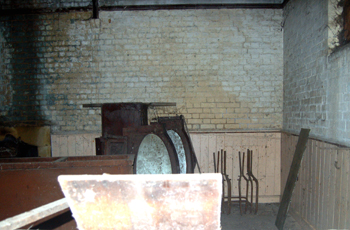
The interior of the former Council School February 2010
The first report, made on the first anniversary of The Armistice (11th November) states; "This little school of about thirty children is a good example of how a single teacher, with the aid of a monitress for the Infants', can teach six standards successfully. Through Nature-study and Handwork the children learn to depend on themselves, and that nice tone of steady application prevails which results in good attainments. Geography and History, which were weak when the present teacher took charge, both shew improvement".
In 1924 the report read: "This School is in every way much above the average of small village schools. The children are thoroughly well behaved, they make a good start in the Infants' Class, work steadily and earnestly and make sound progress all through. The only points which do not reach quite a high level are the Arithmetic of Standard III, the Writing in certain cases and the Note Singing; but it is a pleasure to inspect the School".
In 1927 the inspector said: "The School has recently become a school for children up to 11 years of age. There are 11 on the roll, of whom 10 were present at this visit. They are in 5 groups and the Head Mistress worked them well - together in Singing and Drill, and as individuals in Arithmetic. There are one or two backward children, but the average seems to be normal. The most general weakness is formation of writing and figures. There is a shortage of Readers and Arithmetic text book too; but it would seem that the mistress will be able to carry out her duties successfully, when these are supplied".
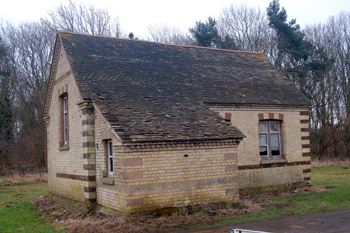
The former village school February 2010
The final report, 1930, reads: "here are 9 children of 10 years and under; and one delicate child of 13 + retained on a medical certificate. Of the juniors proper, 2 (aged 7 and 8) have only been here a month and on arrival could not read a letter or figure; one, aged 9 who has been here a year, on his arrival was much in the same backward state. It is therefore pleasant to be able to say that the progress made in these cases is very satisfactory and that the good management of the varied powers and intelligence of the children, noted in the last report, is still obvious. There is a good variety of interest: country dances and handwork are attractive and the children come to school early in order to correct arithmetic or get on with their handwork as the case may be. Of the ordinary work reading is good, and speech in Recitation very well corrected; examinations are full; arithmetic carefully and successfully taught, but the book in use at present does not give much practice in setting out the story of a problem. The least satisfactory feature is as was reported 3 years ago the formation of handwriting and figures. The Head Mistress may be congratulated on the effect of her work".
Little Barford was too small a community to maintain a school. This is shown by some of the last entries in the logbook [SDLittleBarford1/1]. On 20th January 1932 it was recorded: "4 children were present this morning and 3 this afternoon. Beryl Bishop is absent owing to a cough, Audrey Sewell is poorly today, Robert Broughton has small scabs on his body and Emily Broughton is also absent this afternoon for no reason". It later transpired that Audrey Sewell had influenza. On 11th March the teacher wrote: "Emily, Robert and May Broughton have left. They have gone to live at Colmworth. No. on roll 4". On 2nd May Reginald John Bidwell was admitted, aged 10, bringing the number on the roll to five.
On 20th June the teacher wrote: "I have today received notice to terminate my engagement as Headmistress at this School in three months time, consequent upon the decision of the Education Committee to close this school". The last entry in the book is 28th July: "This School closes permanently today at 12 o'clock. The three scholars now on the roll are being transferred to Sandy". The council school had lasted just eighteen years.
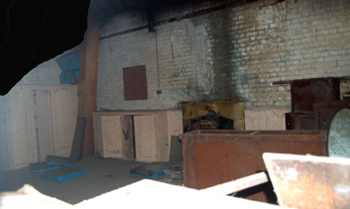
The school interior February 2010
The school had a second lease of life. It was reopened between 1939 and 1945 for children who lived in the village and for evacuees. The first entry, on 16th October 1939, reads: "This Log Book arrived for Little Barford School which re-opened on Sept 13 1939, Village Children and Evacuees from Walthamstow" [SDLIttleBarford1/2].
In October 1939 there were 41 pupils; of which 35 were evacuees. A library was quickly set up for the children in the school. In January 1940 they had a half holiday and went to see the pantomime at the Royal Theatre in Bedford. This treat was paid for through the Greater London Christmas Treat Fund. In contrast to the fun, there were regular Air Raid Practices so that they children would know what to do in an emergency as on March 6th 1940 ‘Air Raid practice taken at 9:45 am. Children proceed to homes or nearest house. Time taken 4 mins.’ There were also gas mask drills and safety checks. In August 1940 the policy of sending children home changed and the building was made safer so that children could stay in school during an air raid warning. By VE Day in 1945 only a few evacuees remained, most having returned home earlier in the war. The school was closed on 27th July 1945 and the village children returned to their schools in Sandy and Tempsford. The last entry reads: "The school closed today. It was re-opened (on account of conditions arising from the outbreak of the European war on Sept. 1st 1939) to provide education for evacuees and children affected by de-reorganization, from Sandy and Tempsford Council Schools. Mrs. M. E. Johnson, Walthamstow, evacuated teacher, gave up her charge of the school this afternoon".
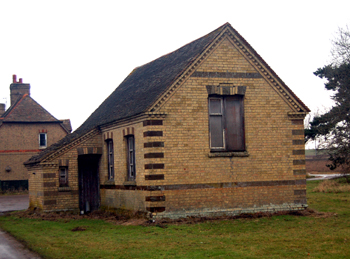 The former Little Barford Council School February 2010
The former Little Barford Council School February 2010